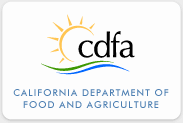Proposals to Adopt, Amend or Repeal Certain AHFSS Regulations
- Animal Health and Food Safety Services – California Building Standards Commission
- Animal Health Branch – No Regulatory Changes Pending
- Livestock Identification – Modified Point of Origin Inspection Areas.
- Meat and Poultry Inspection Branch – Poultry Meat Inspection
- Milk and Dairy Food Safety Branch – Petition for Approval of a Temporary Standard
- Milk and Dairy Food Safety Branch – Somatic Cell Counts in Milk
California Building Standards Commission (CBSC)
Animal Health Branch
No Regulatory Changes Pending
Bureau of Livestock Identification
Meat and Poultry Inspection Branch
- MPI Poultry Notice (PDF 52 KB)
- MPI Poultry Text w/last page showing MPI Tags (PDF 973 KB)
- MPI ISR (PDF 171 KB)
- MPI Poultry Final Proposed Text (PDF 359 KB)
- MPI Tags (JPG 60 KB)
Milk and Dairy Food Safety Branch
- Notice of Public Hearing (PDF 137 KB)
- Petition for Temporary Standard Approval (PDF 334 KB)
- Notice of Extension of Public Hearing (PDF 37 KB)
- Response to Petition for Temporary Standard (PDF 116 KB)
- Somatic Cell Count Notice (PDF 30 KB)
- Somatic Cell Count Text (PDF 17 KB)
- Somatic Cell Count ISR (PDF 28 KB)
For a complete set of California regulations, visit the California Code of Regulations web
site.
For Information on regulations pertaining to interstate movement of
animals, including California, check the USDA state regulations
page.
For more specific questions about California interstate movement
regulations, please call 916-651-6278 Monday through Friday 8-5 pm
pacific time.
For a complete set of Federal Government Regulations, visit the Code of Federal
Regulations web site.
For international regulations call the USDA Veterinary Services
office at: 916-854-3900 Monday through Friday from 7:30 to 4:00 or
visit the USDA Veterinary
Services Import/Export web site.
Code
- California code relating to Animal Health
- For a complete set of the California code, visit the California Food and Agricultural Code web site.
California's agricultural abundance is a reflection of the people who made the Golden State their home. In the process, they brought their agricultural heritage with them. Early California farmers and ranchers were the Spanish missionaries, followed by Mexicans, Japanese, Chinese and Russians. Today, nearly every nationality is represented in California agriculture.
The California Department of Food and Agriculture strives to support this tradition of innovation and agricultural diversity by working with private industry, academia and public sector agencies. These partnerships allow the department to adapt public policy to a rapidly changing industry -- California agriculture.
Back to top of page

